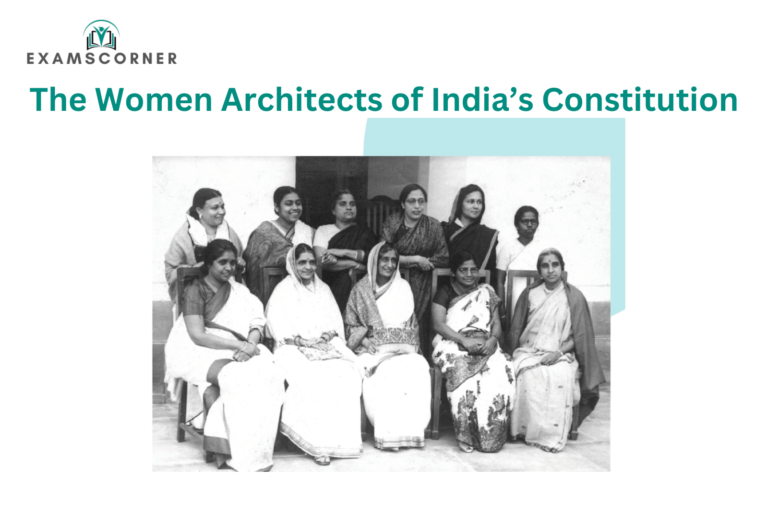The journey of Indian women toward equality is a story of resilience, foresight, and transformative action. It spans decades of struggle for representation, suffrage, and socio-economic rights, culminating in the creation of the Indian Constitution in 1950. Among the 299 members of the Constituent Assembly, 15 women brought intellectual rigor, ethical vision, and a deep commitment to justice. These women—lawyers, activists, social reformers, and nationalists—laid the groundwork for a legal and social framework that continues to influence India’s democratic fabric, They are the Women Architects of India’s Constitution.
The Fight for Representation
The struggle for women’s suffrage in India gained momentum in the early 20th century, inspired by global suffragette movements. In 1917, Sarojini Naidu presented a historic statement to the Viceroy of India, Lord Chelmsford, demanding that gender not be a disqualification for voting or public service. This demand marked the beginning of a nationwide campaign for women’s political participation.
Organizations such as the Women’s India Association (WIA), the National Council of Women in India, and the All India Women’s Conference (AIWC) mobilized women across the country. Journals like Stri-Dharma, Indian Ladies Magazine, and Bamabodhini Patrika provided platforms for debate and advocacy. Leaders like Annie Besant, Margaret Cousins, and Kamaladevi Chattopadhyay brought international perspectives to the movement, connecting Indian suffragists to global networks of support.
By the 1930s, women in India had won the right to vote and stand for elections in various provinces. The AIWC, established in 1927, played a pivotal role in advocating for equal rights and influencing policy. Its members were instrumental in drafting key documents, including the 1931 Karachi Resolution and the 1945 Indian Woman’s Charter of Rights and Duties, which laid the foundation for women’s rights in independent India.
The Women of the Constituent Assembly
When the Constituent Assembly convened on December 9, 1946, it included trailblazing women leaders who had long been at the forefront of India’s freedom struggle. These women brought with them decades of activism, legal expertise, and a commitment to gender justice.
- Hansa Mehta and Rajkumari Amrit Kaur were principal architects of the AIWC Charter of Rights and Duties. Mehta is credited with ensuring that Article 1 of the Universal Declaration of Human Rights read “All human beings are born free and equal,” instead of “All men.”
- Dakshayani Velayudhan, the first Dalit woman elected to the legislative council, opposed separate electorates for minorities, advocating for unity and inclusivity.
- Durgabai Deshmukh, the only woman lawyer in the Assembly, worked on dismantling patriarchal laws and drafting policies that protected women’s rights.
- Vijaya Lakshmi Pandit, Sucheta Kripalani, Purnima Banerji, and Begum Aizaz Rasul were prominent voices who contributed to debates on equality, rights, and decentralization.
Their collective efforts ensured that the Constitution enshrined gender equality as a fundamental right. Article 15 explicitly prohibited discrimination based on sex, and provisions for equal pay, maternity benefits, and inheritance rights were included in the Directive Principles of State Policy.
Balancing Reform and Tradition
The women of the Constituent Assembly understood the delicate balance between reforming entrenched patriarchal structures and navigating the socio-political realities of a newly independent nation. They emphasized equality over identity, rejecting separate electorates for women and instead advocating for universal suffrage.
Sarojini Naidu’s 1918 speech captured this ethos: “We ask for franchise, we ask for vote, not that we might interfere with you… but rather that we might lay the foundation of national character in the souls of the children that we hold upon our laps.”
Legacy and Unfinished Work
The framework established by these women reshaped women’s relationship with law and society. However, the journey toward gender equality remains incomplete. In 1975, the Towards Equality report revealed that despite legal advancements, the socio-economic status of women had stagnated. Many of the demands outlined in the AIWC’s Charter of Rights—such as equal pay, non-discrimination in employment, and greater representation in public life—remain pressing issues today.
In the 2014 elections, Indian women’s groups presented a “womanifesto” echoing the demands of 1946, but with calls for guaranteed representation through reserved seats. This shift highlights the enduring challenge of ensuring women’s voices are adequately heard in India’s democracy.
Conclusion
The women architects of India’s Constitution were pioneers who combined defiance with pragmatism, crafting a legal framework that championed equality and justice. Their vision continues to inspire efforts to build a society where gender is not a barrier to opportunity. As India reflects on its journey since independence, it owes much to these trailblazers who dared to reimagine the role of women in the nation’s destiny.
Source: Mint



